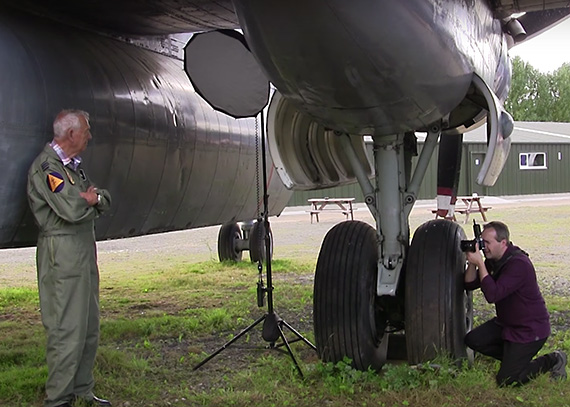A wide angle lens is an excellent choice for environmental portraiture. Its ability to capture the story behind a scene is unmatched. With a large range of vision, photographers can seize plenty of details and action happening in a specific location rather than focusing primarily on a single subject or model.
However, wide angle lenses bring their own set of challenges to overcome. In this particular photo shoot, Hoey struggles to mediate between getting an expansive shot while also working around a bulky yet necessary supplemental light source:
Here are just a few creative compromises Hoey shares that could make a difference when it comes to bringing to life a shot that involves a bit of problem solving:
Change your shooting position
Sometimes, the only action necessary in masking a troublesome foreground element is a simple step forward. In this scenario, moving closer to the subject allowed for Hoey’s softbox to remain in place while not appearing in the photo’s frame. Avoid getting too close to your subject when taking this course of action – the closer you get, the more you risk details becoming somewhat distorted because of the angle of the lens.
Move your light away from the model
This solution may sound obvious, but if a supplementary light or stand is impeding the shot you want, try moving it out of the way. Hoey moved his light stand more in line with the angle at which he was shooting, completely removing it from the camera’s view. However, you should take into consideration that moving the light farther away may reduce the overall light illuminating your subject. In addition, any mood that you may have been cultivating with an artificial light may be sacrificed when repositioning for the sake of composition.
Hide the light within the environment
In this particular shoot, Gavin Hoey was working with a pilot and airplane. After positioning his stand behind the wheel and engine of the plane, the problematic softbox was completely hidden. Of course, “hiding” problem elements will not be a viable option for every shoot. Nevertheless, even partially concealing the unwanted detail can save you plenty of time in post production by cutting down on the areas requiring touch ups and clone stamping.
Composite two photographs
Rather than sacrificing the even, flat lighting a flash can provide, it’s possible to combine a photograph of a scene with flash to a photograph without. All that’s required is a little bit of foresight and a tripod. Once Hoey’s softbox had been triggered once, he simply moved the light source out of the way and created a second exposure. In post, he then stacked the photographs on top of one another. As he demonstrated in the studio afterwards, any minor movements between frames can be fixed in post by auto aligning the image layers in Photoshop. From there, eliminating the unwanted light source takes just a little bit of masking.
When faced with technical conflicts, it’s important to view the issue at hand as a hurdle rather than a roadblock. Just because the tools at hand may not seem to be initially compatible with one another does not mean that all hope of the shot you want is lost. More often than not, reaching your aesthetic goals requires nothing more than a little change in perspective.
Like This Article?
Don't Miss The Next One!
Join over 100,000 photographers of all experience levels who receive our free photography tips and articles to stay current:







Leave a Reply